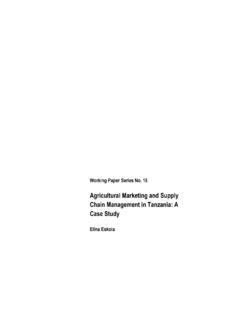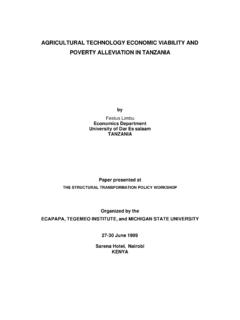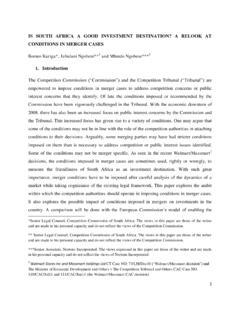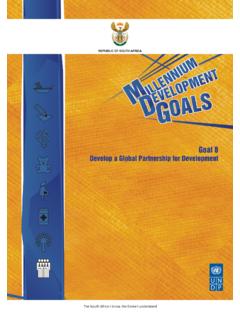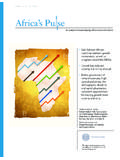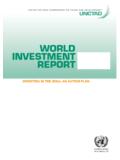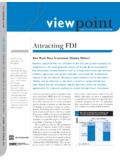Transcription of TOURISM POLICY AND STRATEGIES IN TANZANIA 1.0. …
1 TOURISM POLICY AND STRATEGIES IN TANZANIA . INTRODUCTION. The United Republic of TANZANIA is the 2n d largest country in the SADC. Region and the 1st biggest in East Africa. It lies in the east coast of Africa between Latitudes 1 and 11 degrees South of the Equator. It covers 945,234 square Kilometres comprising Mainland and the islands of Zanzibar and Pemba. The estimated population of TANZANIA for the year 1998 was Million with an annual growth rate of per year. The country has tropical climate with average temperatures of between 25 and 30degree Celsius. Long rains last from March to May, short rains from October to December with some heavy showers in the south and Southern Highlands from December to April. The central plateau is dry and arid with hot days and cool nights, while the northwest highlands are cool and temperate. Coastal areas are hot and humid although sea breezes cool the area pleasantly between June and September.
2 Tanzanians are well known for their hospitality, open and jovial sense of humour, friendly approach and generosity to foreigners. The people are endowed with a wealth of culture, history and artistic talent that has put TANZANIA on the world map as one of the leading nation in that respect. The Government of TANZANIA views TOURISM as a significant industry in terms of job creation, poverty alleviation, and foreign exchange earnings. TOURISM today is receiving a greater attention than ever before from international development agencies and from national TOURISM POLICY and STRATEGIES in TANZANIA Page 1 of 14. governments. To many countries, TOURISM is the highest foreign exchange earner and an important provider of employment. According to the World TOURISM Organization, in 2000 there were 698. million tourist arrivals worldwide that generated US $ billion. According to the statistics in 2000, Africa region showed average annual growth rate of in arrivals.
3 Statistics available also indicate that, Africa's market share in 1999 was Given the size of our continent, the beauty of Africa, the diversity and uniqueness of TOURISM attractions in Africa, there is stillroom for a bigger growth in both tourist arrivals and receipts. TANZANIA is therefore determined to have its fair share in this important industry. Performance of TOURISM Sector in TANZANIA TOURISM in TANZANIA plays a vital role in the country's economic development. It is one of the major sources of foreign exchange. The industry is also credited for being one that offers employment opportunities either directly or indirectly through its multiplier effect. The sector directly accounts for about 16% of the GDP and nearly 25%. of total export earnings. It directly supports the estimated 156,050 jobs (2000). Foreign exchange receipts from TOURISM grew from US$ million in 1995 to $ million in 2001.
4 These receipts were generated by tourists' arrivals in the stated years, which have shown a steady growth from 295,312 in 1995 to 525,000 in 2001. With an average growth rate of 20%, we hope to reach the target of one million tourists by the year 2010. The sector also plays a major role in enhancement of national and international peace and understanding. The table below shows TANZANIA tourist arrivals and earnings (1990- 2001). TOURISM POLICY and STRATEGIES in TANZANIA Page 2 of 14. Table 1. International TOURISM trends in TANZANIA , 1990-2001. Year No. Of Tourists Changes (%) Foreign currency earning Change (%) over us $ million previous year 1990 153000 1991 186800 1992 201744 1993 230166 1994 261595 1995 295312 1996 326188 1997 359096 1998 482331 1999 627325 2000 501669 2001 525000 Source: Ministry of Natural Resources and TOURISM , TOURISM Division National TOURISM POLICY and STRATEGIES The first National TOURISM POLICY was adopted in 1991 to provide the overall objectives and STRATEGIES necessary to ensure sustainable TOURISM development in the country.
5 Nearly a decade later, there have been considerable changes on the political, economic and social fronts within the country, which raised the need for regular review of the POLICY . The thrust of these changes have been towards stimulating efforts to expand the private sector, in tandem with the disengagement of the Government from the sole ownership and operation of tourist facilities. Knowing the potentiality of TOURISM sector, as a strategy for poverty alleviation, the National TOURISM POLICY of TANZANIA was reviewed in 1999 to cope with the dynamism of the TOURISM industry. The overall objective of the POLICY is to assist in efforts to promote the economy and livelihood of the people, essentially poverty alleviation through encouraging the development of sustainable and quality TOURISM that is culturally and socially acceptable, ecologically friendly, TOURISM POLICY and STRATEGIES in TANZANIA Page 3 of 14.
6 Environmentally sustainable and economically viable. It is also sought to market TANZANIA as favoured tourist destination for touring and adventure in a country renowned for its cultural diversity and numerous beaches. The Government recognises that the private sector plays a major role in the industry's development, with the Government playing the catalytic role of providing and improving the infrastructure as well as providing a conducive climate for investment . STRATEGIES for TOURISM Development To effect the implementation of the POLICY , there is an Integrated TOURISM Master Plan, which outlines STRATEGIES and programmes for the sector. The primary focus of this plan is to obtain sustainable benefits for the people of TANZANIA by generating additional economic activity from available resources. Six primary areas addressed by the Integrated TOURISM Master Plan are the following: v Creating greater awareness of TANZANIA in the TOURISM source markets.
7 V Expanding TOURISM products v Securing a more competitive position v Maximizing the necessary service skills, and v Establishing the necessary structures and controls to underpin TOURISM development. The Integrated TOURISM Master Plan outlines details of each area and how to implement it. Promotion of Private investment in the Economy The Government is fully aware that increased investment and technological advancement require deliberate promotional policies. It is in this respect that, the Government decided to gradually pull out of productive and commercial activities and concentrate in its traditional TOURISM POLICY and STRATEGIES in TANZANIA Page 4 of 14. role of maintaining law and order. It has been decided that the commanding heights of the economy, which used to be in the hands of the Government, should be in the able hands of the private sector. The Government considers private investments (both foreign and local).
8 As the engine of growth. It has taken steps to provide a macro economic framework and an enabling environment for private investors to operate. To strengthen private sector in TOURISM industry in TANZANIA , the Government assisted in the formation of TOURISM Confederation of TANZANIA (TCT), a private sector body that is intended to be the representative, voice of the TOURISM private sector interests. Thus, the private sector is being assigned an increasing role in TANZANIA 's overall economic development. The Government's role is to regulate, promote, facilitate and provide very conducive environment for the sustained growth and development of TOURISM . The private sector is thus engaged in development, promotion and marketing of TOURISM products, construction of tourist accommodation facilities; and provision of tour packages and other related services for the sector's sustainable development.
9 To encourage private investment in the country, investment incentives have been put in place. investment INCENTIVE PACKAGES IN TANZANIA . TANZANIA offers a well-balanced package of incentives to investors. These include: - v Recognition of private property and protection against any non- commercial risks. TANZANIA is an active member of the World Bank Foreign investment Insurance wing, Multilateral investment Guarantee Agency (MIGA). TOURISM POLICY and STRATEGIES in TANZANIA Page 5 of 14. v TANZANIA is a member of the Int ernational Canter for investment Settlement Disputes (ICSID) a body affiliated to World Bank. v Zero percent (0%) import Duty on project capital goods. v VAT exception on ground transport run by Tour Operators. v The right to transfer outside the country 100% of foreign exchange earned, profits and capital. v The ease of obtaining other permits such as Residence/ Work Permit, industrial licence, trading licence etc.
10 V Automatic permit of employing 5 foreign nationals on the project holding Certificate of incentives. These incentives have so far attracted good number of investors in the country. For instance TANZANIA investment Centre has between September 1990 and march 1998, approved a total of 152 TOURISM projects worth $ 313 Million, out of which, 119 were new projects. Competitive Strengths of TANZANIA TOURISM Development: The strength of the appeal of TANZANIA to tourist product is dominated by natural assets of the country. The assessment is that by any standards, TANZANIA is an exceptionally beautiful and interesting country. With its 12 National parks, 31 Game reserves, 38 Game controlled areas, a Conservation area and Marine park, Tanzanians wildlife resources are considered among the finest in the world and have been widely known for many years. They include the great Serengeti plains, the spectacular Ngorongoro Crater, Lake Manyara and Africa's highest mountain, Kilimanjaro, in the north, Mikumi, Udzungwa and Ruaha National parks and Selous game Reserve in the south.

